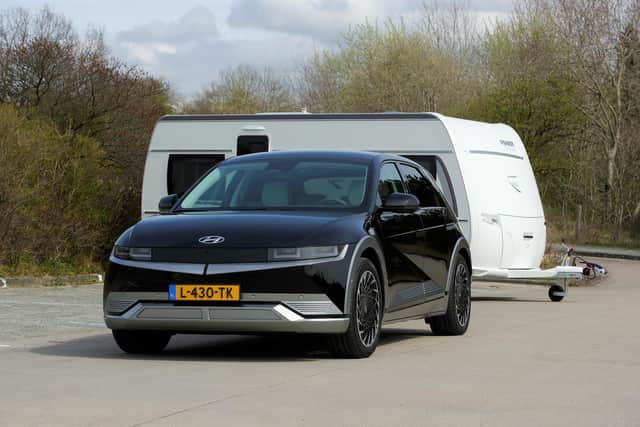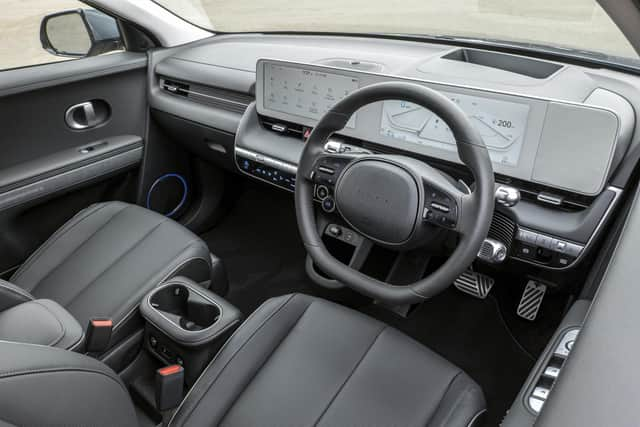Derry Journal MOTORING with Jim McCauley: Test Drive the Hyundai IONIQ 5
and live on Freeview channel 276
The angular styling with hatchback profile envelops the underlying technologies that modern cars require to qualify for the top EuroNCAP safety ratings. It has also attracted world-wide recognition winning in the prestigious 2022 World Car Awards, being named overall World Car of the Year, World Electric Vehicle of the Year and World Car Design of the Year.
The car pushes the boundaries for a compact SUV, sitting at 4.6 metres long and 1.9 metres wide with a 3.0 metre wheelbase on this new dedicated BEV chassis. The IONIQ 5 is the first model from the company to use the Electric-Global Modular Platform (E-GMP) as they further their rollout of all-electric vehicles.
Advertisement
Hide AdAdvertisement
Hide AdThis all-wheel drive model in ‘Ultimate’ specification features an electric motor on each axle, powered by the recently upgraded 77.4 kWh battery. Output is rated at 325 PS (239kW) and with a torque figure of 605 Nm, it achieves the benchmark 0-62mph time in 5.2 seconds.


Keyless entry gives access to the push button starter, and gear selection is on a steering column mounted pod which is simply twisted in the direction in which you wish to travel. The car creeps forward silently until the tyre noise on the road surface confirms travel. Despite its performance and option to increase it on ‘Sport’ mode, it offers a comfortable but nevertheless well supported ride, achieving that fine balance of acceptability by both driver and passengers. A wide, deep windscreen provides excellent forward visibility while the twin screen dash provides a 12-inch, full-touch infotainment screen and twinned 12- inch digital gauge cluster for the driver.
Control layout is simple to follow, keeping information to a minimum with a head-up display duplicating relevant output. A drive mode button on the steering wheel allows for a choice of sharper or more economical throttle response.
With regards to driver support technologies, the IONIQ 5 is equipped with the next level of the company’s ‘SmartSense’, advanced driver assistance system, and is the first Hyundai model to offer Highway Driving Assist 2.
Other driving assistance systems include Forward Collision-Avoidance Assist, Blind-Spot Collision-Avoidance Assist, Intelligent Speed Limit Assist, Driver Attention Warning, and High Beam Assist. The technologies also assures the safety of backseat passengers with Safe Exit Assist, which helps keep the rear doors closed by maintaining the electronic child lock when there is oncoming traffic.


Standard parking assistance features include Remote Smart Parking Assist which allows the driver to remotely park or exit a parking spot from outside the vehicle. This works for both parallel and perpendicular parking and can be activated via a button on the vehicle’s smart key.
Advertisement
Hide AdAdvertisement
Hide AdFor the passengers, the interior is cavernous, offering excellent front and rear room in a cabin that features unobtrusive styling with two-tone light grey upholstery adding to the sense of space. Hyundai points out that many of its interior touchpoints - seats, headliner, door trim, floor and armrest - use eco-friendly, sustainably sourced materials, such as recycled PET bottles, plant-based or natural wool yarns, as well as eco-processed leather.
For luggage, there is 531 litres of boot space, which increases up to almost 1,600 litres when the rear seats are fully folded. For added versatility, these seats can slide forward up to 135 mm and also be folded in a 6:4 ratio. There is also a front storage trunk that provides a further 57 litres acting as a useful tidy container for charge cables.
The car is also capable of towing with a trailer capacity of up to 1,600 kg and additionally features V2L (Vehicle to Load) output with 13amp UK sockets capable of supplying up to 3.6kW of power. The latest version of its upgraded ‘Bluelink’ connected car services displays the vehicle’s range, battery state and charging times when plugged into public or private charging points.
With regards to running costs, a week’s driving on local roads averaged 3.6 miles/kWh with a 100% charge giving a range of 209 miles (Ambient temp: 7 degrees C.) The model reviewed costs in the region of £50,000 depending on customer options. The car comes with Hyundai’s five year unlimited mileage warranty package, five years of roadside assistance and five years of vehicle health checks. The high voltage battery warranty is 8 years or 100,000 miles.